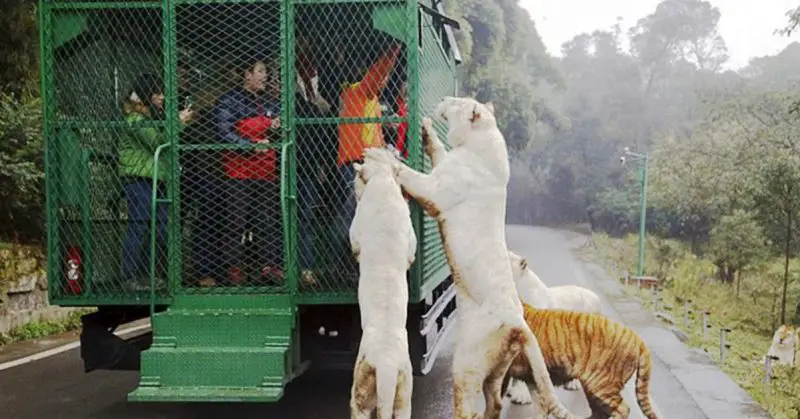This is not a video game. It’s a real-life zoo with honest-to-goodness animals… in reverse. Surprised?
There is no doubt that we humans love our animal friends; after all, we are higher animals according to science. Little wonder man’s best friend is not man. And what is better than connecting with friends?
We are constantly in awe of what Mother Nature has offered us. Her impressive mastery of art-in-science. The stripes, spots, amazing colors, hilarious forms, weird shapes, tusks, and humps. A kingly roar or a bubbly quack. These ecstatic sights and sounds are the reasons why humans are so in love with animal zoos, but what if we got a taste of what the animals feel for a change?
When tables turn…

In 2015, a zoo in China got creative and decided to reverse the entire process. At the Lehe Ledu Wildlife Zoo, tucked in the Chongqing city of China, you can find all species of big cats strolling around uncaged. Who let the cats out?
This unique style keeps zoo-goers in moving trucks with walls made of wire mesh material. These ‘cages’ are designed with small openings through which the animals may be fed, much like an African safari without the cars. Lions, Bengal tigers, white tigers, and bears are allowed to roam freely within their enclosures.
The animals are then enticed to give visitors a warm welcome by jumping at the lumps of meat suspended from the cages. Bait would usually include live chickens. The majestic felines and menacing bears gather around the cages to be fed by the visitors. The motive? Top-notch daredevil entertainment.

This zoo’s style puts tourists in close contact with the wild creatures lounging around them. The daring proximity is believed to add to the thrill by amplifying the adrenaline surge. For the bold and adventurous, this is an exciting experience.
For the zoo, the concept is rewarding as it enjoys widespread popularity. Spokeswoman Chan Liang reports that ‘’we wanted to give our visitors the thrill of being stalked and attacked by the big cats but with, of course, none of the risks.’’ [1]
A few concerns

Worried about safety? You are not alone. Numerous safety concerns have been raised about this method of entertainment.
Is it entirely fail-proof or is this a disaster waiting to happen?
Visitors are instructed to keep their hands safely inside the cages. It’s probably a good idea for your phones to stay in too. Just in case an animal goes into selfie mode and mistakes your fingers for hearty French fries.
If you ever visit, your safety is your first objective, before the fun. Leaving the cages to take a stroll may make you comfort food for Bengal tigers.

How do animals feel in regular zoos?
Across the globe, there are over 10,000 zoos collectively receiving about 600 million visits every year. [2] Zoos are undeniably fun places for kids and adults alike. However, are they really fun for their animal inhabitants?
These animals vary in shape, size, and behavior evoking a wide range of emotions. An interesting blend of awe, fear, and excitement.
Zoos can be set up in different styles. There are traditional zoos with cages and safari zoos where the animals roam free. The latter style is often touted as a more natural option for animals.
Over the years, zoos have received lots of criticism and bad media for a variety of reasons. These range from the unnaturalness of the settings, cramped up spaces, animal mistreatment, and captive breeding. Animal rights activists have opposed the idea of traditional zoos for decades now. On the same note, the safari zoos have also received an unhealthy dose of criticism.
Freedom for Animals opines that zoos are generally miserable places for animals. [3]
Visitors often pet these animals. The animals are in turn trained to carry out often debasing displays to keep the visitors attracted.
Passionate zoo advocates have counter-claimed that zoos are places of protection, especially for endangered species. This group believes that some kinds of animals fare better in zoos than grappling with the harsh realities of the food chain. Dr. Dave Hone says that a significant number of animal species are found only in captivity. Also, some species of this group will only be found in the wild when released from captivity or due to an increase in the wild population by those bred in captivity. [4]
References
- “10 Facts about Zoos.” Freedom for Animals. Retrieved September 25, 2020.
- “At A Zoo In China Humans Are Caged Up As Animals Roam Free.” Intelligent Living. Luana Steffen. Retrieved September 25, 2020.
- “19 Heartbreaking Animals in Captivity Statistics.” Pet Pedia. Filip Isakov. Retrieved September 25, 2020.
- “Why Zoos are good.” The Guardian. Dr. Dave Hone. Retrieved September 25, 2020.

